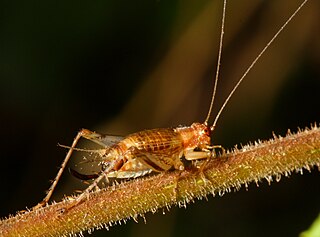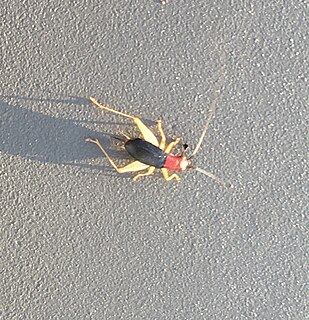
A triangulation station, also known as a trigonometrical point, and sometimes informally as a trig, is a fixed surveying station, used in geodetic surveying and other surveying projects in its vicinity. The nomenclature varies regionally: they are generally known as trigonometrical or triangulation stations in North America, trig points in the United Kingdom, trig pillars in Ireland, trig stations or points in Australia and New Zealand, and trig beacons in South Africa. Triangulation pillar is the more formal term for the concrete columns found in the UK, however, the informal term, "trig point", is used more often.

Trigonidiinae is a subfamily of insects in the order Orthoptera, suborder Ensifera, based on the type genus Trigonidium. They are often referred to as sword-tail crickets, winged bush crickets or trigs.
Kerguelenatica delicatula is a species of predatory sea snail, a marine gastropod mollusk in the family Naticidae, the moon snails.

Rostellariella delicatula, common name the delicate tibia, is a species of sea snail, a marine gastropod mollusk in the family Rostellariidae, the true conchs.

Limestone Corner is an area of Hadrian's Wall at its most northerly point, in present-day northern England. It represents the most northerly point of the Roman Empire, outside the two periods during which the Antonine Wall was occupied by the Roman military. Other notable features at Limestone Corner are the wall ditch at this point, which was never completely excavated, a Roman camp and the site of Milecastle 30. Also present is a trig point. The B6318 Military Road also runs through Limestone Corner, as does the Military Way, serving Milecastle 30. The Military Way is visible on the ground at this point, the most eastern point where this is the case.

Anaxipha is a genus of brown sword-tail cricket from tropical areas in the Americas, Africa, Asia, Australia and western Pacific islands.

The spotted lanternfly is a planthopper that is indigenous to parts of Southern China, Taiwan, and Vietnam, and has spread invasively to Japan, South Korea, and the United States. Although it has two pairs of wings, it jumps more than it flies. Its host plants include grapes, stone fruits, and Malus species, although its preferred host is Ailanthus altissima. In its native habitat it is kept in check by natural predators or pathogens. It was accidentally introduced in South Korea in 2006 and has since been considered a pest. In September 2014, it was first recorded in the United States, and as of 2020 it is an invasive species in the Delaware Valley, northern Delaware, eastern Maryland, eastern Pennsylvania, southwestern New Jersey, New York, Connecticut, northern Virginia, and Ohio.
Apitua delicatula is a species of sea snail, a marine gastropod mollusk in the family Mangeliidae.

Lycorma is a genus of insects in the family Fulgoridae: subfamily Aphaeninae; species are found in Asia. L. delicatula, known as the Spotted lanternfly, is an invasive species.

Anaxipha exigua is a cricket in the genus Anaxipha, in the subfamily Trigonidiinae. Common names are "Say's trig" and "Say's bush cricket". The distribution range of Anaxipha exigua includes the Caribbean and North America.
Psoloessa is a genus of slant-faced grasshoppers in the family Acrididae. There are at least four described species in Psoloessa.

Phyllopalpus pulchellus, known generally as the red headed bush cricket,handsome trig or handsome bush cricket, is a species of winged bush crickets, trigs in the family Gryllidae. It is found in North America.

Hemerotrecha is a genus of windscorpions in the family Eremobatidae. There are more than 30 described species in Hemerotrecha.
Psoloessa delicatula, the brown-spotted range grasshopper, is a species of slant-faced grasshopper in the family Acrididae. It is found in North America.
Neocladura delicatula is a species of limoniid crane fly in the family Limoniidae.
Podmosta is a genus of spring stoneflies in the family Nemouridae. There are about six described species in Podmosta.
Cymatodera delicatula is a species of checkered beetle in the family Cleridae. It is found in Central America and North America.
Myrciaria delicatula, commonly known as cambuí uvaia doce, cambuí graudo, cambuim, or cambu branco, is a species of plant in the family Myrtaceae.
Guinardia is a genus of diatoms belonging to the family Rhizosoleniaceae.







